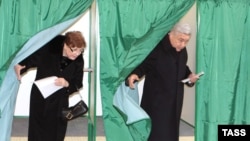To no one's surprise, the pro-Kremlin Unified Russia party, which dominates both chambers of the Russian parliament, emerged as the strongest party in local parliamentary elections in nine Russian regions on March 1.
The election results in the North Caucasus republics of Kabardino-Balkaria (KBR) and Karachayevo-Cherkessia (KChR) mirrored the overall trend, with Unified Russia winning an absolute majority in both regions (72.2 percent and 69.3 percent, respectively). But in both cases, support for Unified Russia was considerably lower than in the Russian State Duma elections of December 2007, in which that party polled more than 96 percent in the KBR and 92.9 percent in the KChR.
In the KBR, all four parties that registered for the March 1 ballot managed to surmount the 7 percent minimum required to win parliamentary representation. A Just Russia polled second with 11.2 percent (compared with less than 1 percent in the Duma elections) , the Communist Party third with 8.3 percent (compared with 1.72 percent in December 2007), and the Liberal Democratic Party of Russia (LDPR) 7.02 percent (0.41 percent in the Duma elections).
Last summer, when the KBR parliament amended the election law to eliminate voting in single-mandate constituencies, some politicians had warned that the result would be a one-party parliament dominated by Unified Russia. Voter turnout exceeded 80 percent.
In Karachayevo-Cherkessia, Patriots of Russia placed second with 11.2 percent in the party-list voting and the Communists third with 10.4 percent. With some votes still uncounted, the remaining two parties, A Just Russia and the LDPR, had polled 5 percent and 2.80 percent. Just days before the ballot, the Communists and Patriots of Russia had issued a statement alleging that the outcome of the ballot had been dictated in advance from Moscow, and that neither party would poll the required minimum 7 percent.
The KChR still has a mixed system, with 37 candidates elected from single-mandate constituencies and 36 on the basis of party lists, so the precise distribution of seats in the new legislature remains unclear. Nor is it clear whether any of the imams who registered as candidates in the Ust-Djegut Raion and defied persuasion from the KChR presidential administration to withdraw were actually elected.
LDPR leader Vladimir Zhirinovsky told journalists in Moscow on March 2 that the voting in both Karachayevo-Cherkessia and Tatarstan was marred by violations on a massive scale, and that the results were rigged, regnum.ru reported. He said his party will demand the resignation of the KChR president who, Zhirinovsky alleged, was behind the orders not to permit any candidates on the LDPR party list to win election.
Elections also took place in the KChR on March 1 for the heads of three administrative districts, including the Nogai Raion formed in December 2006. The Nogai election will go to a second round in which Magomed Sanglibayev, head of the Nogai national movement Birlik, will face off against Mukhamed Djimakulov.
The election results in the North Caucasus republics of Kabardino-Balkaria (KBR) and Karachayevo-Cherkessia (KChR) mirrored the overall trend, with Unified Russia winning an absolute majority in both regions (72.2 percent and 69.3 percent, respectively). But in both cases, support for Unified Russia was considerably lower than in the Russian State Duma elections of December 2007, in which that party polled more than 96 percent in the KBR and 92.9 percent in the KChR.
In the KBR, all four parties that registered for the March 1 ballot managed to surmount the 7 percent minimum required to win parliamentary representation. A Just Russia polled second with 11.2 percent (compared with less than 1 percent in the Duma elections) , the Communist Party third with 8.3 percent (compared with 1.72 percent in December 2007), and the Liberal Democratic Party of Russia (LDPR) 7.02 percent (0.41 percent in the Duma elections).
Last summer, when the KBR parliament amended the election law to eliminate voting in single-mandate constituencies, some politicians had warned that the result would be a one-party parliament dominated by Unified Russia. Voter turnout exceeded 80 percent.
In Karachayevo-Cherkessia, Patriots of Russia placed second with 11.2 percent in the party-list voting and the Communists third with 10.4 percent. With some votes still uncounted, the remaining two parties, A Just Russia and the LDPR, had polled 5 percent and 2.80 percent. Just days before the ballot, the Communists and Patriots of Russia had issued a statement alleging that the outcome of the ballot had been dictated in advance from Moscow, and that neither party would poll the required minimum 7 percent.
The KChR still has a mixed system, with 37 candidates elected from single-mandate constituencies and 36 on the basis of party lists, so the precise distribution of seats in the new legislature remains unclear. Nor is it clear whether any of the imams who registered as candidates in the Ust-Djegut Raion and defied persuasion from the KChR presidential administration to withdraw were actually elected.
LDPR leader Vladimir Zhirinovsky told journalists in Moscow on March 2 that the voting in both Karachayevo-Cherkessia and Tatarstan was marred by violations on a massive scale, and that the results were rigged, regnum.ru reported. He said his party will demand the resignation of the KChR president who, Zhirinovsky alleged, was behind the orders not to permit any candidates on the LDPR party list to win election.
Elections also took place in the KChR on March 1 for the heads of three administrative districts, including the Nogai Raion formed in December 2006. The Nogai election will go to a second round in which Magomed Sanglibayev, head of the Nogai national movement Birlik, will face off against Mukhamed Djimakulov.




